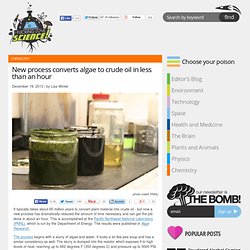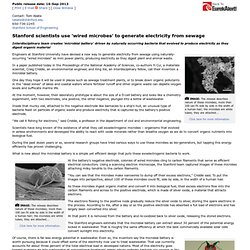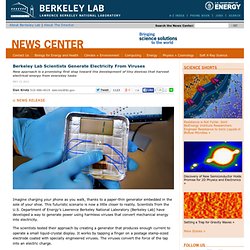

Streetlamps Go Green. New process converts algae to crude oil in less than an hour. It typically takes about 65 million years to convert plant material into crude oil - but now a new process has dramatically reduced the amount of time necessary and can get the job done in about an hour.

This is accomplished at the Pacific Northwest National Laboratory (PNNL), which is run by the Department of Energy. The results were published in Algal Research. The process begins with a slurry of algae and water. It looks a lot like pea soup and has a similar consistency as well. The slurry is dumped into the reactor which exposes it to high levels of heat, reaching up to 662 degrees F (350 degrees C) and pressure up to 3000 PSI. Once the crude oil has been isolated, the team can use traditional refining techniques to make gasoline, diesel, and jet fuel.
Algae has been the focus of a source for biofuel for a long time, but the success from PNNL comes from their ability to streamline the operation and use wet algae, instead of incurring the expense of having to dry the algae first. Stanford scientists use 'wired microbes' to generate electricity from sewage. Public release date: 16-Sep-2013 [ Print | E-mail Share ] [ Close Window ] Contact: Tom Abatetabate@stanford.edu 650-736-2245Stanford School of Engineering Engineers at Stanford University have devised a new way to generate electricity from sewage using naturally-occurring "wired microbes" as mini power plants, producing electricity as they digest plant and animal waste.

In a paper published today in the Proceedings of the National Academy of Sciences, co-authors Yi Cui, a materials scientist, Craig Criddle, an environmental engineer, and Xing Xie, an interdisciplinary fellow, call their invention a microbial battery. One day they hope it will be used in places such as sewage treatment plants, or to break down organic pollutants in the "dead zones" of lakes and coastal waters where fertilizer runoff and other organic waste can deplete oxygen levels and suffocate marine life. "You can see that the microbes make nanowires to dump off their excess electrons," Criddle said. Berkeley Lab Scientists Generate Electricity From Viruses. News Release Imagine charging your phone as you walk, thanks to a paper-thin generator embedded in the sole of your shoe.

This futuristic scenario is now a little closer to reality. Scientists from the U.S. Department of Energy’s Lawrence Berkeley National Laboratory (Berkeley Lab) have developed a way to generate power using harmless viruses that convert mechanical energy into electricity. The scientists tested their approach by creating a generator that produces enough current to operate a small liquid-crystal display. Their generator is the first to produce electricity by harnessing the piezoelectric properties of a biological material. The milestone could lead to tiny devices that harvest electrical energy from the vibrations of everyday tasks such as shutting a door or climbing stairs.
It also points to a simpler way to make microelectronic devices. MIT creates glucose fuel cell to power implanted brain-computer interfaces. Neuroengineers at MIT have created a implantable fuel cell that generates electricity from the glucose present in the cerebrospinal fluid that flows around your brain and spinal cord.

In theory, this fuel cell could eventually drive low-power sensors and computers that decode your brain activity to interface with prosthetic limbs. The glucose-powered fuel cell is crafted out of silicon and platinum, using standard semiconductor fabrication processes. The platinum acts as a catalyst, stripping electrons from glucose molecules, similar to how aerobic animal cells (such as our own) strip electrons from glucose with enzymes and oxygen.
The glucose fuel cell products hundreds of microwatts (i.e. tenths of a milliwatt), which is a surprisingly large amount — it’s comparable to the solar cell on a calculator, for example. This should be more than enough power to drive complex computers — or perhaps more interestingly, trigger clusters of neurons in the brain. Freak discovery could lead to new biofuel. Boeing reveals “the biggest breakthrough in biofuels ever”- Plants that can be grown in the desert with salt water, easily broken into carbohydrates. : science. Sweden imports waste from European neighbors to fuel waste-to-energy program. When it comes to recycling, Sweden is incredibly successful.

Just four percent of household waste in Sweden goes into landfills. The rest winds up either recycled or used as fuel in waste-to-energy power plants. Burning the garbage in the incinerators generates 20 percent of Sweden’s district heating, a system of distributing heat by pumping heated water into pipes through residential and commercial buildings. It also provides electricity for a quarter of a million homes. According to Swedish Waste Management, Sweden recovers the most energy from each ton of waste in the waste to energy plants, and energy recovery from waste incineration has increased dramatically just over the last few years.
The problem is, Sweden’s waste recycling program is too successful. Catarina Ostlund, Senior Advisor for the Swedish Environmental Protection Agency said the country is producing much less burnable waste than it needs. However, they’ve recently found a solution. Corn Ethanol Is Of No Use.